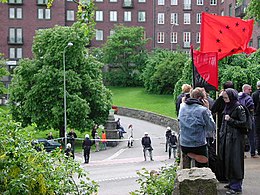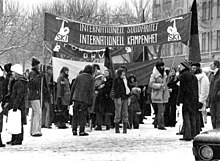Anarchism in Sweden

| Part ofa serieson |
| Anarchism |
|---|
 |
Anarchism in Swedenfirst grew out of the nascentsocial democraticmovement during the later 19th century, with a specifically libertarian socialist tendency emerging from a split in the movement. As with the movements in Germany and the Netherlands, Swedish anarchism had a strongsyndicalisttendency,[1]which culminated in the establishment of theCentral Organisation of the Workers of Sweden(SAC) following an abortedgeneral strike.The modern movement emerged during the late 20th century, growing within a number of countercultural movements before the revival ofanarcho-syndicalismduring the 1990s.[2]
History and influence
[edit]Anarchism was reported to have been extant in Sweden byMikhail Bakuninas early as 1866.[3]
Anarchist ideaswere prominent in theSwedish Social Democratic Party(SAP) from its founding in 1889 to the early 1900s, with a number of anarchists includingHinke Bergegrenbecoming leading members. After the exclusion of Bergegren and other anarchists from the SAP in 1908, the party's youth organization – theYoung Socialists(Swedish:Ungsocialisterna) – broke away to form a separateanti-parliamentary socialistparty.[2]
Following the defeat of theGreat Strike of 1909,a number of Young Socialists participated in the foundation of ananarcho-syndicalisttrade union, theSveriges Arbetares Centralorganisation(SAC).[4]DuringWorld War I,the SAC received support from the German syndicalistAugustin Souchy,while in theUnited States,the Swedish labor organizerJoe Hillwas executed.[2]The rise of anarcho-syndicalism influenced the magazineBrand,which had been published since 1898, to turn towards anarchism during the 1910s, going on to become the oldest continuously published anarchist magazine in Sweden.[2][5]

The Swedish anarchist movement experienced a resurgence as a result of theprotests of 1968,although by this time the Young Socialist Party had ceased to exist. Further attempts to rekindle a national organisation were largely short-lived, with anarchist presence instead taking root in the risingcountercultureof the 1970s, particularly within thepunk subcultureand nascentintentional communities.By the 1980s, Swedish anarchists had come under the influence of theGerman autonomist movement,with a number ofsquatsbeing established throughout the country, and by the following decade,green anarchismwas embraced by an increasing number of Swedish anarchists.[2]
Following therevolutions of 1989,Swedish interest in anarcho-syndicalism was revived. The SAC had continued its activities and grew to over 6,500 members, remaining active in labor organizing up until the modern day. In 1993, theSwedish Anarcho-syndicalist Youth Federation(SUF) was established as a youth organization in collaboration with the SAC.[2]
One of many minor anarchist groups are theFag Army,a left-wingqueer anarchistgroup, which launched its first action on August 18, 2014, when itpiedtheMinister for Health and Social Affairs,Christian DemocratleaderGöran Hägglund.[6]
Notable anarchists
[edit]Organizations
[edit]- Young Socialists(1908-1968)
- Central Organisation of the Workers of Sweden(1910-present)
- Syndicalist Workers Federation(1928-1938)
- Lund's Anarchist Group(1969-1973)
- Swedish Anarcho-syndicalist Youth Federation(1993-present)
References
[edit]- ^Woodcock 2004,p. 366.
- ^abcdefKuhn 2009,p. 1.
- ^Woodcock 2004,p. 135.
- ^Campbell 1992,p. 435.
- ^"Om | Tidningen Brand".tidningenbrand.se.Retrieved2016-01-15.
- ^"Christian Democrat leader attacked with cake".The Local.18 August 2014.Retrieved20 August2014.
Bibliography
[edit]- Campbell, Joan (1992).European Labor Unions.Westport: Greenwood Press.ISBN0-313-26371-X.
- Kuhn, Gabriel(2009). "Anarchism, Sweden". In Ness, Immanuel (ed.).The International Encyclopedia of Revolution and Protest.pp. 1–2.doi:10.1002/9781405198073.wbierp0074.ISBN9781405198073.OCLC8682127155.
- Woodcock, George(2004).Anarchism: A History of Libertarian Ideas and Movements.Peterborough: Broadview Press.ISBN1-55111-629-4.
Further reading
[edit]- Lundström, Markus (2023). "When Anarchism Met Punk". In Hill, Helena; Pinto, Andrés Brink (eds.).Social Movements in 1980s Sweden: Contention in the Welfare State.Palgrave Studies in the History of Social Movements. Cham: Springer International Publishing. pp. 81–109.ISBN978-3-031-27370-4.
- Vila, Roland; Hallbert, Thomas Hallon (1983).Anarki till vardags: en bild av alternativ rörelsen: en föraning om ett alternativt samhälle[Anarchy in everyday life: a picture of the alternative movement, a premonition of an alternative society] (in Swedish). Munkfors: Maximilian.ISBN978-91-7796-000-3.OCLC81197150.
